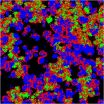(Press-News.org) Recently published research in the University of Eastern Finland found that fatty acid composition in blood is not only a biomarker for the quality of dietary fat but also reflects the quality of dietary carbohydrates. For example the proportion of oleic acid was higher among children who consumed a lot of candy and little high-fibre grain products. Earlier studies on the topic have mainly concentrated on the association of the quality of dietary fat with fatty acid composition in blood. In the present study, the association of the quality of dietary carbohydrates with plasma fatty acid composition was investigated for the first time in children.
A higher consumption of candy and a lower consumption of high-fibre grain products were associated with a higher proportion of oleic acid in blood. One explanation for this finding may be that children who consumed more candy and less high-fibre grain products also consumed more foods rich in saturated fat. Saturated fat, that is known to be harmful to health, has previously been shown to correlate positively with oleic acid intake in Western diet not favoring olive oil.
A higher consumption of candy was associated with a higher estimated delta-9 desaturase that indicates the activity of delta-9-desaturase in liver. A higher intake of carbohydrates has previously been shown to be associated with a higher activity of delta-9-desaturase in adults but the studies on this topic are lacking in children. The delta-9-desaturase is an enzyme that catalyzes the reactions of producing monounsaturated fatty acids from saturated fatty acids. Thus, it prevents the accumulation of saturated fatty acids in the liver but at the same time it promotes the excretion of fatty acids to the blood stream. The increase in delta-9-desaturase activity may be related to an increased production of saturated fatty acids from sugar in the liver that is harmful for lipid metabolism.
A higher consumption of vegetable oil-based margarine containing at least 60 percent fat was associated with higher proportions of polyunsaturated fatty acids, linoleic acid and alfa-linolenic fatty acid in blood that is in line with the results of the previous studies in adults and children. A higher consumption of vegetable oil-based margarine was also associated with lower proportions of saturated fatty acids and monounsaturated fatty acids known to be advantageous to health.
The Physical Activity and Nutrition in Children Study investigates health of children in Kuopio
The present study was conducted in the University of Eastern Finland and it was based on the Physical Activity and Nutrition in Children (PANIC) Study. The PANIC Study is an ongoing exercise and diet intervention study in a population sample of 512 children 6-8 years of age from the city of Kuopio. The consumption of foods was assessed by 4-day food records and the fatty acid composition in blood was assessed by gas chromatograph from a fasting blood sample.
The results of the present study were published in Lipids.
INFORMATION:
For further information, please contact:
M.Sc. Taisa Venäläinen, tel. 040 9635721, taisa.venalainen@uef.fi
Professor Timo Lakka, tel. 040 7707329, timo.lakka@uef.fi
Taisa Venäläinen, Ursula Schwab, Jyrki Ågren, Vanessa de Mello, Virpi Lindi, Aino-Maija Eloranta, Sanna Kiiskinen, David Laaksonen,Timo A. Lakka. Cross-Sectional Associations of Food Consumption with Plasma Fatty Acid Composition and Estimated Desaturase Activities in Finnish Children. Lipids March 14. DOI 10.1007/s11745-014-3894-7.
Fatty acid composition in blood reflects the quality of dietary carbohydrates in children
The fatty acid composition in blood reflects the quality of both dietary fat and carbohydrates
2014-04-07
ELSE PRESS RELEASES FROM THIS DATE:
Why do we get allergies? The science of springtime sniffling and sneezing (video)
2014-04-07
WASHINGTON, April 7, 2014 — Spring has sprung, and with it comes blooming flowers, shorts and t-shirts and, for the millions who suffer from allergies, a runny nose, puffy eyes and general misery. In the American Chemical Society's (ACS') latest Reactions video, we explain the science behind the allergies that spoil spring for so many people. The video is available at http://youtu.be/vFZlxQU0Pyk.
INFORMATION:
Subscribe to the series at Reactions YouTube, and follow us on Twitter @ACSreactions to be the first to see our latest videos.
The American Chemical Society ...
Health benefits of 'green exercise' for kids shown in new study
2014-04-07
Children who are exposed to scenes of nature while exercising are more likely to experience health-enhancing effects after activity, according to a Coventry University study published this week in the International Journal of Environmental Research and Public Health.
Sports science academics in the University's Department of Applied Sciences and Health asked kids aged 9-10 years to complete a series of 15 minute moderate intensity cycling activities – one whilst viewing a video of a forest track synced to the exercise bike and another with no visual stimulus.
The researchers ...
Energizing sick mitochondria with vitamin B3
2014-04-07
Vitamins B have recently been turned out to be potent modifiers of energy metabolism, especially the function of mitochondria.
Vitamin B3, (niacin) has been found to delay the signs of aging in animal models.
An international collaboration between the University of Helsinki and École Polytechnique Fédérale de Lausanne reported today in the high-profile journal, Embo Molecular Medicine, that vitamin B3 form, nicotinamide riboside, can slow down the progression of mitochondrial disease, suggesting its potential as a novel therapy approach to adult-onset mitochondrial ...
Organic solar cells more efficient with molecules face-to-face
2014-04-07
New research from North Carolina State University and UNC-Chapel Hill reveals that energy is transferred more efficiently inside of complex, three-dimensional organic solar cells when the donor molecules align face-on, rather than edge-on, relative to the acceptor. This finding may aid in the design and manufacture of more efficient and economically viable organic solar cell technology.
Organic solar cell efficiency depends upon the ease with which an exciton – the energy particle created when light is absorbed by the material – can find the interface between the donor ...
Switching off anxiety with light
2014-04-07
Receptors for the messenger molecule serotonin can be modified in such a way that they can be activated by light. Together with colleagues, neuroscientists from the Ruhr-Universität Bochum (RUB) report on this finding in the journal "Neuron". An imbalance in serotonin levels seems to cause anxiety and depression. The researchers have provided a new model system for investigating the mechanism underlying these dysfunctions in cell cultures as well as living organisms.
G protein coupled receptors play an important role in medicine and health
One receptor, which is important ...
The tiniest greenhouse gas emitters
2014-04-07
Climate feedbacks from decomposition by soil microbes are one of the biggest uncertainties facing climate modelers. A new study from the International Institute for Applied Systems Analysis (IIASA) and the University of Vienna shows that these feedbacks may be less dire than previously thought.
The dynamics among soil microbes allow them to work more efficiently and flexibly as they break down organic matter – spewing less carbon dioxide into the atmosphere than previously thought, according to a new study published in the journal Ecology Letters.
"Previous climate ...
Exploring the genetics of 'I'll do it tomorrow'
2014-04-07
Procrastination and impulsivity are genetically linked, suggesting that the two traits stem from similar evolutionary origins, according to research published in Psychological Science, a journal of the Association for Psychological Science. The research indicates that the traits are related to our ability to successfully pursue and juggle goals.
"Everyone procrastinates at least sometimes, but we wanted to explore why some people procrastinate more than others and why procrastinators seem more likely to make rash actions and act without thinking," explains psychological ...
Green tea boosts your brain
2014-04-07
Green tea is said to have many putative positive effects on health. Now, researchers at the University of Basel are reporting first evidence that green tea extract enhances the cognitive functions, in particular the working memory. The Swiss findings suggest promising clinical implications for the treatment of cognitive impairments in psychiatric disorders such as dementia. The academic journal Psychopharmacology has published their results.
In the past the main ingredients of green tea have been thoroughly studied in cancer research. Recently, scientists have also been ...
New method for prostate cancer detection can save millions of men painful examination
2014-04-07
Each year prostate tissue samples are taken from over a million men around the world – in most cases using 12 large biopsy needles – to check whether they have prostate cancer. This medical procedure, which was recently described by an American urology professor as 'barbaric'**, shows that 70% of the subjects do not have cancer. The examination is unnecessarily painful and involves risk for these patients, and it is also costly to carry out. A patient-friendly examination, which drastically reduces the need for biopsies, and may even eliminate them altogether, has been ...
Rilpivirine combination product in pretreated HIV-1 patients: added benefit not proven
2014-04-07
The German Institute for Quality and Efficiency in Health Care (IQWiG) reassessed the antiviral drug combination rilpivirine/emtricitabine/tenofovir. In early 2012, the combination was approved for the treatment of adults infected with human immunodeficiency virus type 1 (HIV-1) who have not received previous antiretroviral treatment. For men, the Institute then found proof, and for women, indications of a considerable added benefit of the fixed combination in comparison with the appropriate comparator therapy.
In the end of 2013, the approval was expanded to people ...
LAST 30 PRESS RELEASES:
American College of Cardiology comments on new dietary guidelines for Americans
American Society of Gene & Cell Therapy and Orphan Therapeutics Accelerator partner to advance and commercialize promising rare disease treatments
One in 14 patients having day case surgery have new or worse chronic pain 3 months after their operation
New study highlights link between eviction rates and gun violence
Heatwaves heat up soil but not toxin levels in rice, study finds
Digital modeling reveals where construction carbon emissions really come from
Turning farm waste into water filters
New study shows how the spleen helps the immune system accept a transplant
New Mayo Clinic study advances personalized prostate cancer education with an EHR-integrated AI agent
Researchers identify novel therapeutic target to improve recovery after nerve injury
Microbes in breast milk help populate infant gut microbiomes
Reprogramming immunity to rewrite the story of Type 1 diabetes
New tool narrows the search for ideal material structures
Artificial saliva containing sugarcane protein helps protect the teeth of patients with head and neck cancer
Understanding the role of linear ubiquitination in T-tubule biogenesis
Researchers identify urban atmosphere as primary reservoir of microplastics
World’s oldest arrow poison – 60,000-year-old traces reveal early advanced hunting techniques
Bristol scientists discover early sponges were soft
New study uncovers how rice viruses manipulate plant defenses to protect insect vectors
NSF–DOE Vera C. Rubin Observatory spots record-breaking asteroid in pre-survey observations
Ribosomal engineering creates “super-probiotic” bacteria
This self-powered eye tracker harnesses energy from blinking and is as comfortable as everyday glasses
Adverse prenatal exposures linked to higher rates of mental health issues, brain changes in adolescents
Restoring mitochondria shows promise for treating chronic nerve pain
Nature study identifies a molecular switch that controls transitions between single-celled and multicellular forms
USU chemists' CRISPR discovery could lead to single diagnostic test for COVID, flu, RSV
Early hominins from Morocco reveal an African lineage near the root of Homo sapiens
Small chimps, big risks: What chimps show us about our own behavior
We finally know how the most common types of planets are created
Thirty-year risk of cardiovascular disease among healthy women according to clinical thresholds of lipoprotein(a)
[Press-News.org] Fatty acid composition in blood reflects the quality of dietary carbohydrates in childrenThe fatty acid composition in blood reflects the quality of both dietary fat and carbohydrates




